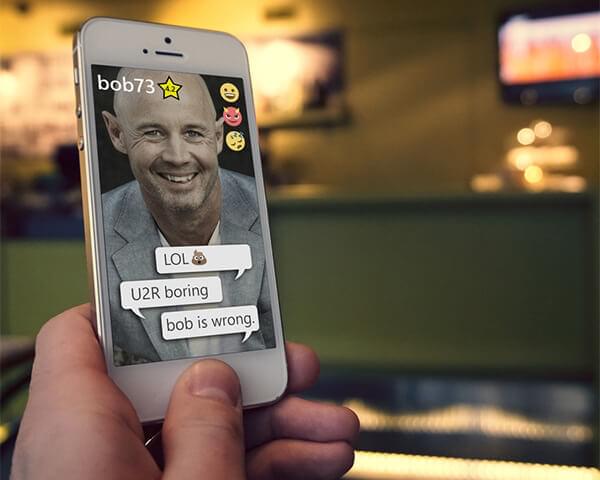
Social media platforms such as MySpace, Bebo, Facebook, Twitter, Snapchat, Instagram, LinkedIn and Google+ have been transformative technologies which shaped the early years of the twenty-first century. People can meet, interact and communicate in ways which would have been impossible a decade earlier.
Despite the ongoing success of social networks, most people’s real and online lives rarely connect in a cohesive manner:
- you have a long list of online “friends” you’ve never met, know or speak with
- your actual friends use different social networks to you
- you disconnect from real-world conversations to join online virtual chats
- you’ll reprimand people for talking nonsense yet believe identical online articles and alerts
- you feel obliged to comment on online articles despite not reading the text or understanding the points raised
- you’ll say things online which would never be said in person-to-person conversations.
Most people live separate online and offline lives. Some even adopt a different online image or persona.
Augmented Reality Social Experiment
Smartphone systems such as Siri and Cortana and screenless devices such as Amazon Echo and Google Home have already begun to revolutionize how we interact with devices. The next step is the Augmented Reality Social Experiment which will finally end the distinction between your real and online lives.
Dr Truly Lyse, the CTO of Distributed Reality Open Social Systems, claims their new software heralds the start of Social Media 2.0:
Starting in April 2017, our Social/Human Interface Technology software will be automatically installed on all your online devices. It will bridge the missing link between disparate social media platforms and real-world activities.
The new system blends social media networks with Augmented Reality to introduce a new level of sophisticated integration between the real and virtual worlds:
- Your face-to-face meetings and conversations will be live-streamed. Audio and text translations will be shared and made instantly available on all your connected social media networks.
- Holding your phone up will automatically record and upload video (bandwidth-permitting). The view is overlaid by further information as necessary.
- Your friends and followers can access your real-world interactions in real time.
- Any of your online contacts can join in the conversation, add comments, submit emojis and rate your discussion.
- Disputes can be settled instantly with online voting to determine who is right or wrong.
Lyse states:
Your real-life conversations will be infinitely enhanced by the addition of other collaborators. The wisdom of crowds is a positive phenomenon: it has been proved infallible in polls, elections and referendums.
Viral Dominance
Your real-world conversations with friends, family and colleagues could make you an instant internet sensation as your discussions go viral and are shared throughout the community. However, Lyse points out the technology will quickly evolve beyond simple interaction enhancements.
Online data input activities will require less effort because the system will be able to recognize your likes, dislikes, habits, relationship statuses and emotional well-being. Friends will know whether you’re hungry, tired, frustrated or euphoric by viewing icons superimposed on your face.
Conversations can be data-mined to highlight media and marketing trends. Your discussion will receive useful interruptions for associated products and news alerts. For example, if you’re feeling unwell, the system can recommend remedies which have been highly rated by others in your social group for similar symptoms.
Finally, your reputation will be enhanced by the quality of your real-life interactions. Others can rate factors such as your intelligence, empathy, confidence and sense of humor to provide an aggregate personality score. Your ranking will become increasingly important:
- It will be more meaningful than a resume for employers.
- Potential partners can filter requests and automatically accept or reject an approach.
The End of Privacy?
Social/Human Interface Technology is not without its critics and there have been privacy concerns. Your PC, smartphone and screenless devices will have received, installed and activated the software by the time you read this article, but strict safeguards and privacy protocols are in place.
You can switch off live-streaming when you want to start a private conversation. To enable private system mode, speak the following activation words clearly into your device:
ENGAGE PRIVATES
Your device will confirm with an audible alert and/or the message “PRIVATE SYSTEM MODE ACTIVATED”. Private system mode will remain engaged until you end the conversation or say:
DISCHARGE PRIVATES
 Alternatively, you can wear a privacy hat. The Social/Human Interface Technology software uses real-time video image recognition and microwave distortion analysis to identify the head-wear of all parties. Private system mode is activated when one or more of your conversation group is wearing the hat so nothing is shared online.
Alternatively, you can wear a privacy hat. The Social/Human Interface Technology software uses real-time video image recognition and microwave distortion analysis to identify the head-wear of all parties. Private system mode is activated when one or more of your conversation group is wearing the hat so nothing is shared online.
There have been supply problems in some parts of the world, but you can make your own privacy hat with a standard sheet of tin foil.
The Future of Social Media
Augmented Reality is the obvious next step for social media. All the popular networks have integrated Social/Human Interface Technology so the system is usable today. Early beta test results were promising, but there will undoubtedly be teething problems during the world-wide launch.
Have you used Social Media 2.0 on your devices? Was the experience positive or negative? Comments welcome.
Frequently Asked Questions about Augmented Reality in Social Media
How is Augmented Reality transforming the landscape of social media?
Augmented Reality (AR) is revolutionizing social media by creating immersive and interactive experiences for users. It allows users to overlay digital information onto their real-world environment, thereby enhancing their perception of reality. This technology is being used in social media platforms to create engaging content, such as filters and stickers, which users can apply to their photos and videos. AR also enables users to virtually try on products, such as clothes and makeup, thereby enhancing their shopping experience on social media platforms.
What are some examples of Augmented Reality applications in social media?
There are numerous examples of AR applications in social media. Snapchat, for instance, was one of the first platforms to introduce AR filters, which allow users to transform their appearance or surroundings in photos and videos. Instagram and Facebook have also introduced similar features. Additionally, platforms like Pinterest are using AR to allow users to virtually try on products. For instance, users can see how a particular shade of lipstick or pair of glasses would look on them before making a purchase.
How does Augmented Reality benefit businesses on social media?
AR offers numerous benefits for businesses on social media. It allows businesses to create engaging and interactive content, which can help to attract and retain customers. AR can also enhance the shopping experience by allowing customers to virtually try on products, thereby increasing the likelihood of purchase. Furthermore, AR can provide businesses with valuable data about their customers’ preferences and behaviors, which can be used to inform marketing strategies.
What is the future of Augmented Reality in social media?
The future of AR in social media looks promising. As technology continues to advance, we can expect to see more sophisticated and immersive AR experiences on social media platforms. This could include more realistic filters and stickers, as well as more advanced virtual try-on features. Additionally, as more businesses recognize the benefits of AR, we can expect to see more AR-based marketing campaigns on social media.
What are the challenges of implementing Augmented Reality in social media?
While AR offers numerous benefits, there are also challenges associated with its implementation. These include technical challenges, such as ensuring that AR experiences run smoothly on different devices and platforms. There are also privacy concerns, as AR requires access to users’ camera and location data. Furthermore, creating high-quality AR content can be time-consuming and expensive, which may be a barrier for smaller businesses.
How can I get started with Augmented Reality in social media?
Getting started with AR in social media involves several steps. First, you need to understand your audience and determine how AR can enhance their experience on your platform. Next, you need to choose the right AR technology for your needs. This could involve using AR features provided by social media platforms, or developing your own AR experiences using AR development tools. Finally, you need to create engaging AR content and measure its effectiveness.
Can Augmented Reality be used in social media marketing?
Yes, AR can be a powerful tool in social media marketing. It allows businesses to create engaging and interactive content, which can help to attract and retain customers. AR can also enhance the shopping experience by allowing customers to virtually try on products, thereby increasing the likelihood of purchase. Furthermore, AR can provide businesses with valuable data about their customers’ preferences and behaviors, which can be used to inform marketing strategies.
How does Augmented Reality enhance user engagement on social media?
AR enhances user engagement on social media by creating immersive and interactive experiences. It allows users to overlay digital information onto their real-world environment, thereby enhancing their perception of reality. This can make social media content more engaging and memorable, thereby increasing user engagement.
What are some examples of successful Augmented Reality campaigns on social media?
There have been numerous successful AR campaigns on social media. For instance, IKEA used AR to allow users to virtually place furniture in their homes, while Sephora used AR to allow users to virtually try on makeup. These campaigns were successful because they provided users with valuable and engaging experiences, thereby increasing brand awareness and engagement.
How can I measure the success of my Augmented Reality campaign on social media?
Measuring the success of an AR campaign on social media involves tracking key performance indicators (KPIs), such as user engagement, conversion rates, and return on investment (ROI). You can also use analytics tools provided by social media platforms to gain insights into how users are interacting with your AR content.
Craig is a freelance UK web consultant who built his first page for IE2.0 in 1995. Since that time he's been advocating standards, accessibility, and best-practice HTML5 techniques. He's created enterprise specifications, websites and online applications for companies and organisations including the UK Parliament, the European Parliament, the Department of Energy & Climate Change, Microsoft, and more. He's written more than 1,000 articles for SitePoint and you can find him @craigbuckler.



